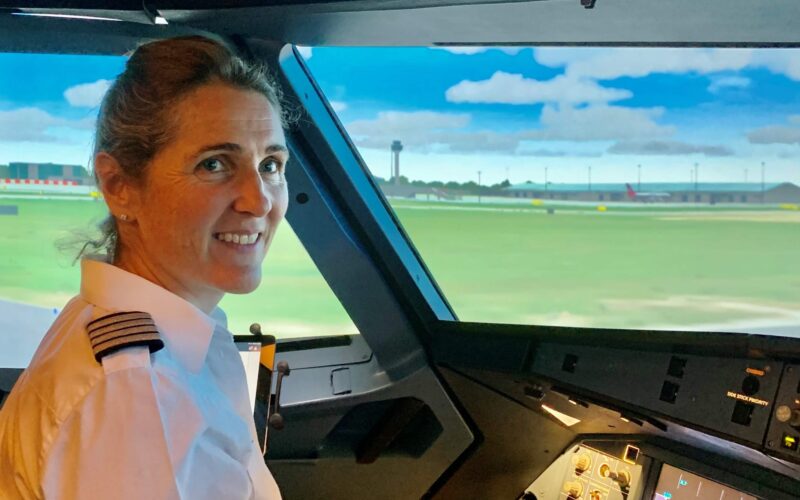There has been some progress made in encouraging women into the aviation industry. But what about taking the next steps up the ladder and looking at training roles?
This is a question that Britain’s Royal Aeronautical Society (RAeS), in conjunction with the University of the West of England (UWE), is currently looking into.
I was lucky enough to have a female flight instructor throughout my basic phase of training on a single-engine piston aircraft. Since then, though, it has been all male instructors, apart from a two-day course on crew resource management in the classroom.
According to UK Civil Aviation Authority data, less than 1.5% of trainers are women. The RAeS and UWE therefore decided to ask pilots worldwide for their views about the barriers to entry, and what can be done to encourage more diversity.
“50% of the population is women. 50% of passengers are women. 5% of pilots are women. But 1.5% of those training pilots are women. So there is something fundamentally wrong,” declares airline pilot Marnie Munns, who is part of the RAeS Flight Crew Training Group.
Munns notes that her first training flight in a Boeing 737 was with an extremely experienced female training captain.
She says: “I thought, ‘Oh, this is good. We’re the second generation female pilots, we’re going to be trained by women.’ But that was the last time I had a female pilot trainer. And that was 21 years ago.”
The study is being led by Professor Sue Durbin of the UWE, who specializes in gender inequalities in employment, and whose work has focussed on women in male-dominated professions.
Munns, who has been involved in training since 2004, continues: “If you want to encourage diversity into the industry, you also need to have a diverse training department, because the first point of contact and regular contact, right through your airline career will be with the training department.”
JUGGLING ACT
Issues such as schedules, childcare, funding and perception are set to be a focus of the group, which is currently analyzing the data gained from the survey and will present it next month.
For example, female pilots are still asked how they manage to combine family life with their careers. It’s a question that male colleagues never seem to face. Perhaps one positive factor stemming from the COVID-19 pandemic is the ongoing debate about flexible working options for all members of staff, not just women.
As with initial pilot training, finance is another big barrier. TRI courses can cost around £10,000-£15,000, ($13,700-$20,600), so the financial outlay may deter some. Yet training qualifications can open pilots up to higher-paid roles in the future. So, if women aren’t becoming trainers, then they are missing out on earnings potential. Some providers have also temporarily dropped prices during the pandemic.
MODERN EXPECTATIONS
The independent study will also explore training methods and hopes to provide commercial airlines with ideas to make training more modern, reflecting the needs and expectations of a new generation of pilots, both women and men.
After all, if trainers are predominantly men in their 50s or 60s, then they were initially trained 40 years ago, when flying was a different world. Since then, the roles of flight engineers and navigator have all but disappeared, while the steam gauges of the past have been replaced with large, high-definition screens and heads-up displays.
Automation has moved the emphasis away from stick-and-rudder skills, while Crew Resource Management (CRM), or effective teamwork and communication, is now vital in ensuring aviation safety.
“We want the pilots that can deal with modern technology today. And they are very different. They’re very different competencies,” Munns says.
GETTING IN EARLY
One issue that might hinder some pilots is that they may not even realize that they can become trainers early on in their careers. You need 1,500 hours to start on the training route, which can be achieved after just a few years in the right-hand seat.
London-based first officer Amy Fonseca Williams completed her Type Rating Instructor (TRI) course last month and has taken part in focus groups for the RAeS/UWE research.
“It’s a subject that’s dear to my heart as a female and a trainer,” Williams explains. “1.5% is just not enough. I want to find out what is stopping people from doing it. The findings will be really interesting and I want to contribute to that”
Williams says that alongside her dad, who is a training captain, she was inspired by some great trainers. “I have been trained by some really great female trainers. But not many. They’re few and far between.”
Munns suggests that the pandemic is the perfect time to implement change, with many pilots already working part-time and companies looking at how they can change to best emerge from the crisis.
She adds: “We’ve had this huge watershed moment. So actually, if you’re going to make a change for the future, then now’s the time to do it as we rebuild.”

